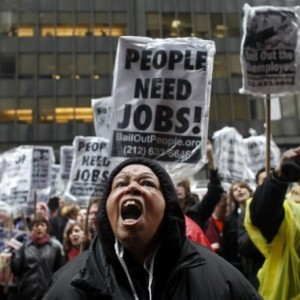Make-Believe America: The US is Said to Have Full Employment, Misleading Statistics

Americans live a never-never-land existence. The politicians and presstitutes make sure of that.
Consider something as simple as the unemployment rate. The US is said to have full employment with a January 2018 unemployment rate of 4.1 percent, down from 9.8 percent in January 2010.
However, the low rate of unemployment is contradicted by the long-term decline in the labor force participation rate. After a long rise during the Reagan 1980s, the labor force participation rate peaked in January 1990 at 66.8 percent, more or less holding to that rate for another decade until 2001 when decline set in accelerating in September 2008.
Today the labor force participation rate is the lowest since February 1978, reversing all of the gains of the Reagan years.
Allegedly, the current unemployment rate of 4.1 percent is the result of the long recovery that allegedly began in June 2009. However, normally, employment opportunities created by economic recovery cause an increase in the labor force participation rate as people join the work force to take advantage of employment opportunities. A fall in the participation rate is associated with recession or stagnation, not with economic recovery.
How can this contradiction be reconciled? The answer lies in the measurement of unemployment. If you have not looked for a job in the last four weeks, you are not counted as being unemployed, because you are not counted as being part of the work force. When there are no jobs to be found, job seekers become discouraged and cease looking for jobs. In other words, the 4.1 percent unemployment rate does not count discouraged workers who cannot find jobs.
The US Bureau of Labor Statistics has a second measure of unemployment that includes workers who have been discouraged and out of the labor force for less than one year. This rate of unemployment is 8.2 percent, double the 4.1 percent reported rate.

Source: Bureau of Labor Statistics
The US government no longer tracks unemployment among discouraged workers who have been out of the work force for more than one year. However, John Williams of shadowstats.com continues to estimate this rate and places it at 22 or 23 percent, a far cry from 4.1 percent.
In other words, the 4.1 percent unemployment rate does not count the unemployed who do show up in the declining labor force participation rate.
If the US had a print and TV media instead of the propaganda ministry that it has, the financial press would not tolerate the deception of the public about employment in America.
Junk economists, of which the US has an over-supply, claim that the decline in the labor force participation rate merely reflects people who prefer to live on welfare than to work for a living and the current generation of young people who prefer life at home with parents paying the bills. This explanation from junk economists does not explain why suddenly Americans discovered welfare and became lazy in 2001 and turned their back on job opportunities. The junk economists also do not explain why, if the economy is at full employment, competition for workers is not driving up wages.
The reason Americans cannot find jobs and have left the labor force is that US corporations have offshored millions of American jobs in order to raise profits, share prices, and executive bonuses by lowering labor costs. Many American industrial and manufacturing cities have been devasted by the relocation abroad of production for the American consumer market, by the movement abroad of IT and software enginering jobs, and by importing lower paid foreign workers on H1-B and other work visas to take the jobs of Americans. In my book, The Failure of Laissez Faire Capitalism, I give examples and document the devastating impact jobs offshoring has had on communities, cities, pension funds, and consumer purchasing power. See also this.
John Williams of shadowstats.com questions whether there has been any real growth in the US economy since the 2008 crisis that resulted from the repeal of the Glass-Steagall Act. Williams believes that the GDP growth rate is an illusion resulting from the understatement of inflation. Just as unemployment is under-counted, so is inflation.
Two “reforms” were introduced that result in the under-measurement of inflation. One is the substitution principle. When the price of an item in the basket of goods used to measure inflation goes up, that item is thrown out and a cheaper substitute is put in its place. The “reformers” argue that consumers themselves behave in this way. Thus, they claim this practice is reasonable. However, the old way of measuring inflation measured the cost of a constant standard of living. The new way measures the cost of a falling standard of living.
The other reform is to classify some price rises as quality improvements rather than as inflation. The consumer has to pay the higher price, but he is said to be getting a better product, and so it is not inflation. There is some truth to this, but it appears it is over-used in order to report low inflation rates. Both of these reforms are suspected of being motivated by holding down Social Security costs by denying cost-of-living (COLA) adjustments to Social Security recipients.
If inflation is under-measured, the use of the measure to deflate nominal GDP in order to arrive at real GDP leaves some price rises in the GDP measure. Therefore, price rises or inflation are counted as increases in real goods and services. John Williams suspects that most of the GDP growth reported since the alleged recovery is simply price rises, not increases in real goods and services.
The historically high stock averages are another feature of make-believe America. The high price/earnings ratios do not reflect strong fundamentals, such as high rates of business investment, strong growth in real retail sales fueled by strong growth in consumer incomes. The Federal Reserve has used an increase in consumer debt to fill in for the missing growth in consumer income for so long that consumers have no more room to take on more debt. Without growth in wages and salaries or in consumer debt, consumer demand cannot drive the economy and business profits.
What explains the high stock prices? The answer is the trillions of dollars the Federal Reserve has created in order to stabilize the large “banks to big to fail” and bail out their extremely poor investment decisions. All of this liquidity found its way into the financial sector where it drove up the prices of stocks and bonds, enriching equity owners and denying retirees any interest income on their savings.
The values of financial instruments are supported by money creation, not by underlying fundamentals. Yet, the stock averages are treated as proof of economic recovery and America’s first place in the world.
As I said, it is never-never-land in which we live.
*
This article was originally published on Paul Craig Roberts Institute for Political Economy.
 Global Research works to give readers critical coverage of such issues and much more.
Global Research works to give readers critical coverage of such issues and much more.
In the face of mainstream media disinformation, we have remained independent and continued to act as a vital information portal. We are grateful to all those involved in this process.
The Centre for Research on Globalization/Global Research do not seek financial support from private and public foundations. This is why we value every single donation and contribution made by our readers.

